After trading at over $13 on OTC markets earlier this year, $EIGEN has been hovering between $3~$4 since its public listing on October 1, with a fully diluted valuation (FDV) of around $5-7 billion. This represents a staggering 70% decline in EigenLayer’s market value in just half a year. Such a sharp drop has left investors perplexed and led to criticism that the highly anticipated innovation of Restaking* has lived up to its hype. In this report, we analyze the underlying causes of $EIGEN’s underperformance and discuss its future outlook.
*For a detailed explanation of the Restaking concept, please refer to the report ‘Restaking Stack: Classifying the Restaking Ecosystem’
The sluggish post-listing performance of $EIGEN can largely be attributed to two key factors that are frequently discussed within the community.
In its April 29, 2024 whitepaper, Eigenlayer introduced $EIGEN as a “Universal Intersubjective Work Token.” This complex and unfamiliar term has made it difficult for the token’s core value to resonate with investors.

Source: Youtube (@Curt Explores)
In simpler terms, $EIGEN’s primary role is to mediate and resolve issues that arise within Actively Validated Services (AVS). But the challenge lies in communicating this effectively.
For example, while the concept is clear to industry insiders, the lack of straightforward messaging about the token's practical utility—especially for retail investors—has created confusion. The complexity of explaining how $EIGEN functions to resolve faults in decentralized systems adds friction to adoption and understanding, especially in an ecosystem filled with competing narratives. Let’s dive deeper into the components of this explanation.
Universal
The word "universal" indicates that $EIGEN is not confined to a single blockchain network. Instead, it can be utilized across a broad spectrum of blockchain infrastructures and applications, such as zk-rollups, bridges, MEV solutions, Trusted Execution Environments (TEEs), and even AGI (Artificial General Intelligence) solutions. This flexibility is made possible because while EigenLayer is rooted in Ethereum, it offers the versatility to handle asset staking and validation tasks across various networks. This broad applicability is a key differentiator for $EIGEN compared to traditional L1 tokens, which are typically tied to a specific blockchain ecosystem.
Work Token
A "work token" refers to a token staked in a network to perform specific tasks. In blockchain terms, these tasks include validating transactions, generating proofs, and ensuring the integrity of the network—processes fundamental to Proof of Stake (PoS) systems. In EigenLayer’s case, $EIGEN and its staked version, $bEIGEN, serve to support these tasks across various AVS. Validators who fail to adhere to protocol rules face economic penalties through slashing, where $bEIGEN is forfeited. This mechanism is similar to traditional PoS systems but extends to a broader range of tasks beyond typical L1 validation, expanding its utility and scope within decentralized services.
Intersubjective
In blockchain environments, faults can be categorized into three broad types: objectively attributable faults, intersubjectively attributable faults, and subjective faults. Intersubjective faults are particularly interesting because they cannot be verified through technical means alone, yet they are universally agreed upon by participants. These faults typically occur in situations involving off-chain data or actions requiring human judgment, such as errors in price feeds or censorship events. The resolution of such faults relies on the collective agreement of the network’s participants, making them a core focus for $EIGEN’s utility. This capacity to handle consensus-driven errors, especially those involving subjective data inputs, sets $EIGEN apart from tokens focused purely on technical validation.
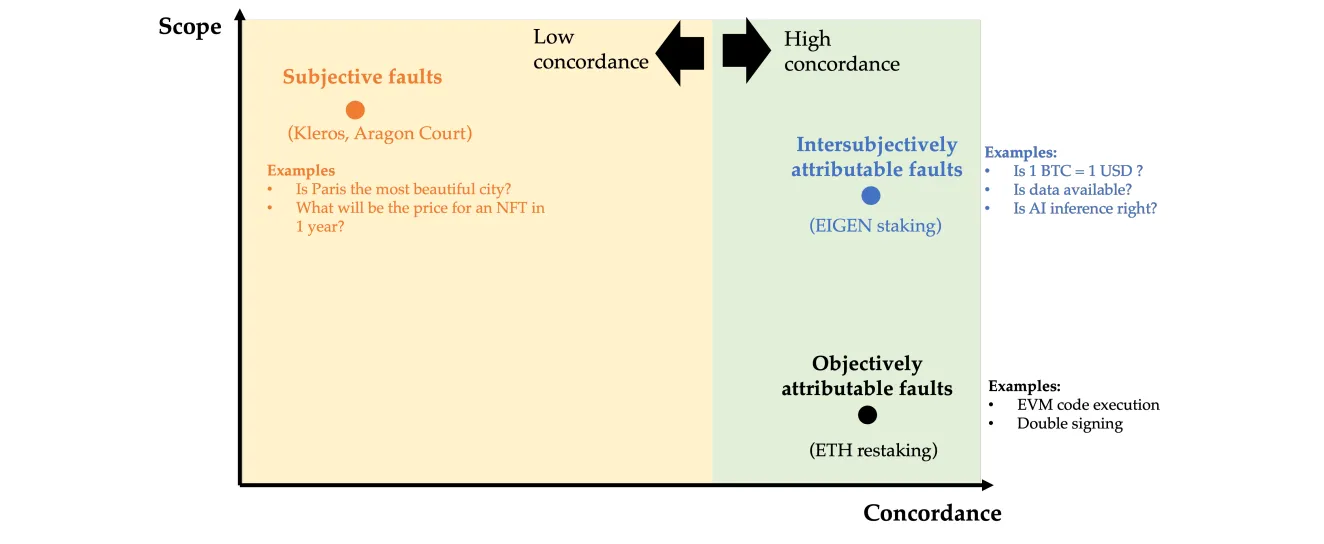
Source: EIGEN: The Universal Intersubjective Work Token | Eigenlayer
As mentioned above, $EIGEN functions as a mediation tool for resolving intersubjective faults—issues that cannot be technically proven as true or false but are universally recognized by participants as errors. For instance, if a validator intentionally submits incorrect data or violates the protocol’s rules, the staked $EIGEN of the malicious party is excluded from the network through a forking process. Forking here isn’t just a separation from the network; it’s a powerful punitive measure that nullifies the value of the tokens held by the offending validator.
Forking Process
When a fault is detected in a specific Actively Validated Service (AVS), a challenger can raise a dispute. To resolve this, the network burns the original $EIGEN and issues a new forked token, $EIGEN2. During this process, the Fork Distributor (FD) contract allows legitimate $EIGEN holders and stakers to redeem their tokens for the new forked version, $EIGEN2. However, the malicious actor’s staked $bEIGEN is prevented from being converted into $bEIGEN2, effectively rendering their assets worthless.
This forking mechanism acts as both a deterrent and a safeguard, ensuring that participants who contribute to the health of the network are protected, while those who act maliciously see the value of their holdings reduced to zero. It’s a strong economic penalty designed to uphold the integrity of the network and ensure that only honest actors are rewarded.
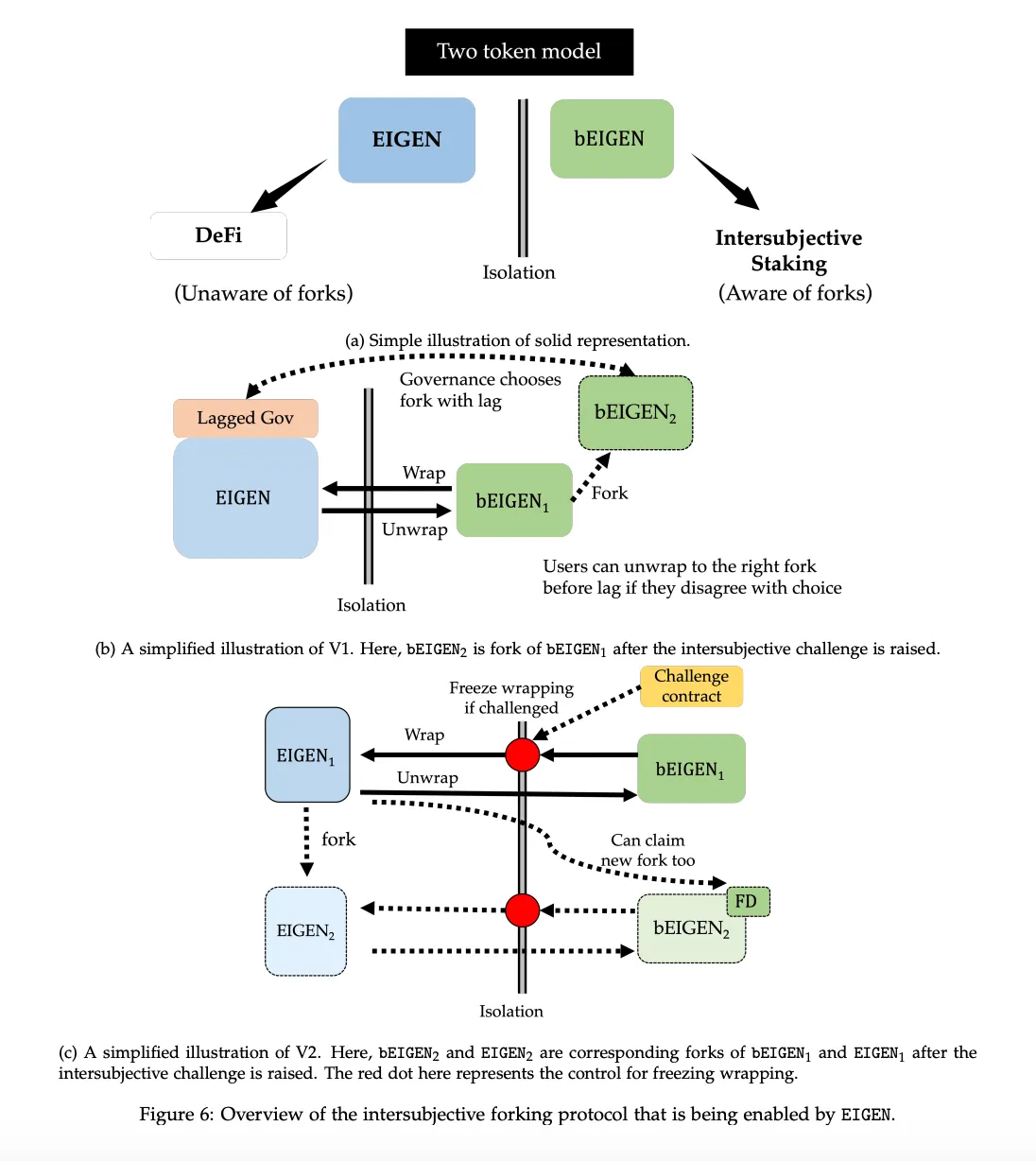
Source: EIGEN: The Universal Intersubjective Work Token | Eigenlayer
At this point, a reasonable question arises: why not use $ETH alone to handle these faults instead of relying on $EIGEN? This is because there is a potential risk of overburdening Ethereum’s consensus mechanism with tasks that require subjective or intersubjective decision-making, as opposed to the objectively verifiable tasks that Ethereum typically handles. Ethereum’s consensus mechanism is designed for tasks that can be deterministically verified, such as validating transactions and ensuring the correct state of the blockchain.
However, when it comes to tasks involving human judgment, like determining the fairness of a particular outcome (e.g., in prediction markets or content moderation), reaching consensus becomes more complex. These tasks could overload Ethereum's social consensus because they require subjective agreement among participants, which isn't as straightforward as verifying cryptographic proofs. By introducing the $EIGEN token, Eigenlayer seeks to offload these subjective tasks to a different consensus layer, thus preserving Ethereum's cryptoeconomic security for objectively verifiable transactions while handling more complex, socially agreed-upon tasks elsewhere.
In conclusion, while the existence of $EIGEN can be justified, its utility remains both clear and ambiguous. Although $EIGEN’s role in enhancing the security of AVS and resolving intersubjective faults is clear in theory, its practical utility remains unfamiliar to many investors. The token’s value is only realized when intersubjective errors occur within the network, which means that in the absence of such issues, its utility might seem less apparent. This makes $EIGEN a niche token, contrasting sharply with meme coins that thrive precisely because they lack any inherent utility but are buoyed by hype.
This was evident in a recent poll conducted by Pinkbrains CEO DeFiIgnas, where over 60% of respondents (2,314 out of 3,839) stated they would prefer investing in $MOG over $EIGEN. This result highlights that investors tend to gravitate toward assets with easily digestible narratives, further underscoring the challenge $EIGEN faces in gaining broader appeal.
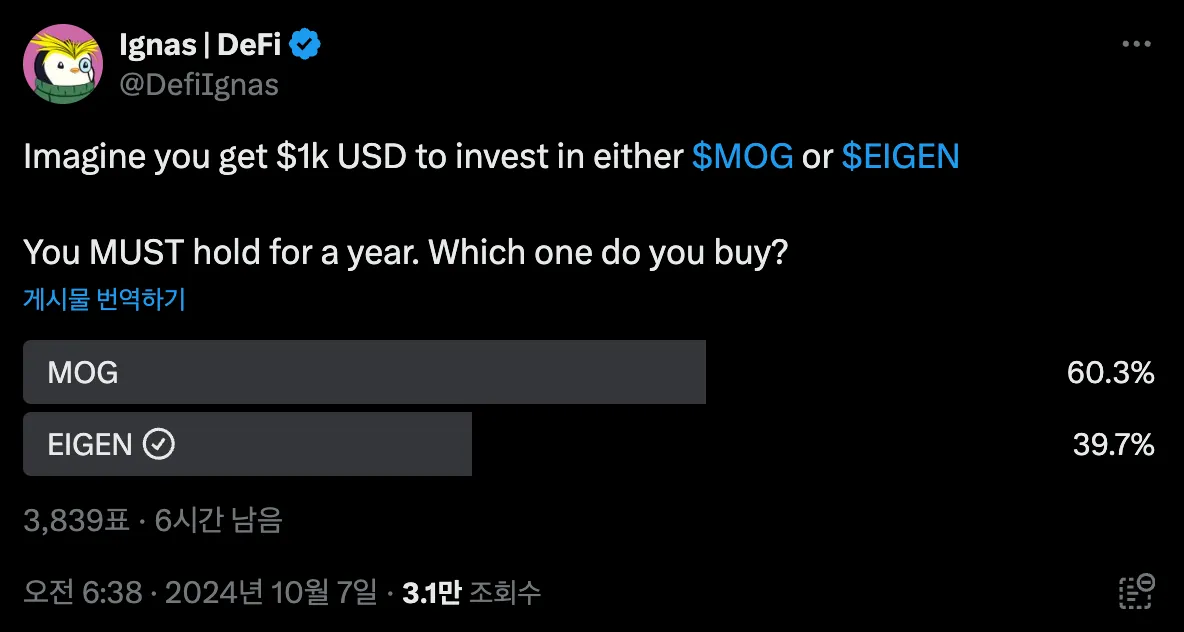
Source: X (@DefiIgnas)
Another key factor contributing to $EIGEN’s recent underperformance is the increased selling pressure from airdrop recipients seeking to lock in profits. This is a common phenomenon observed in many projects following token listings. Historically, many tokens that are airdropped tend to face downward price pressure shortly after their listing, as early recipients often rush to sell their free tokens. For instance, looking at major projects listed in the past year, most tokens experienced significant price declines within the first 30 days of listing. While macroeconomic conditions, valuations, and tokenomics all play a role in these price movements, the substantial impact of airdropped tokens cannot be overlooked.
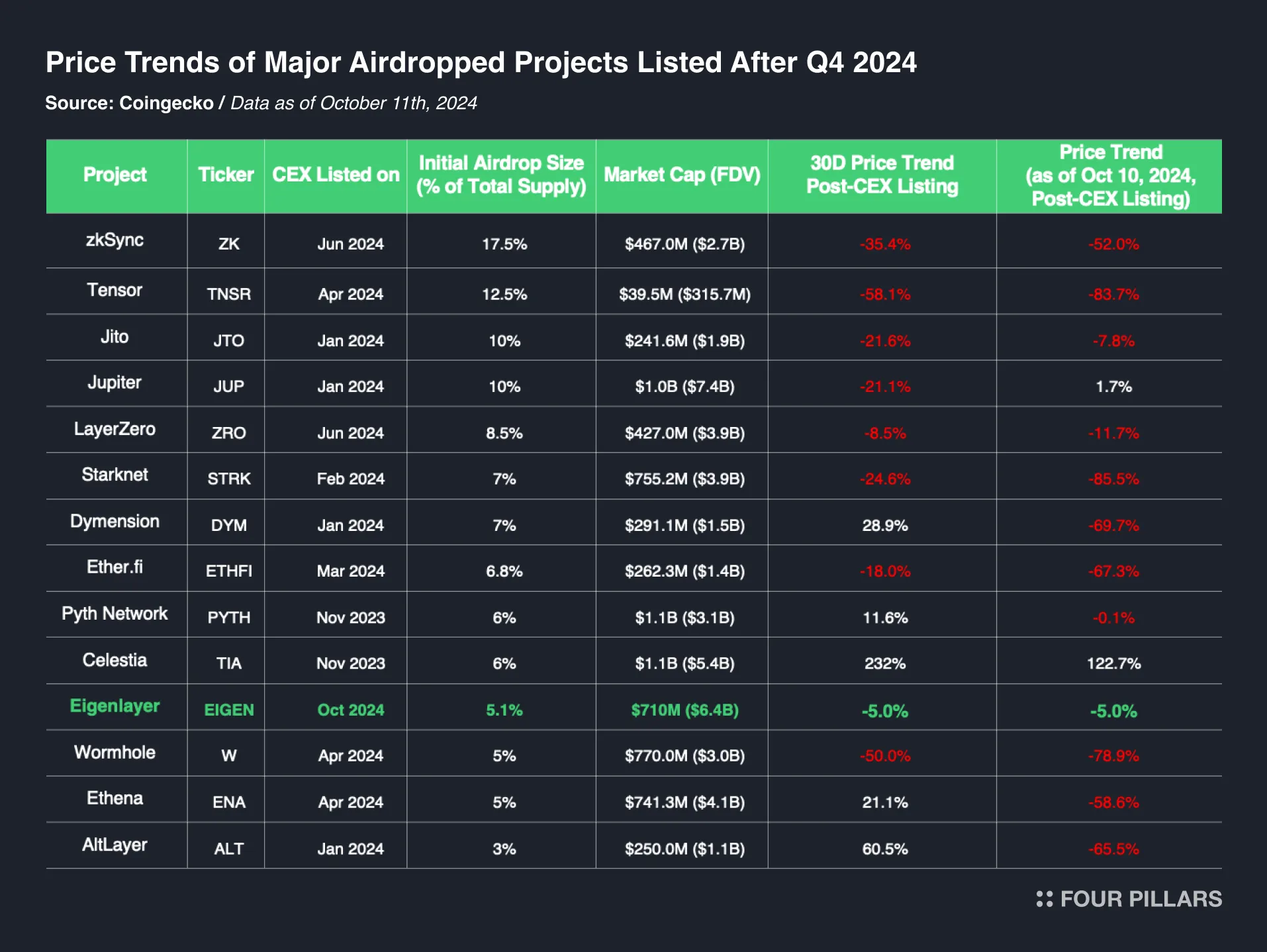
In the case of EigenLayer, out of an initial circulating supply of 185 million $EIGEN, a whopping 46% (around 86 million $EIGEN) came from airdrops. This includes allocations to institutional investors and crypto whales like Blockchain Capital and Galaxy Digital. Notably, Justin Sun and GCR reportedly transferred around $8.75 million and $1.06 million worth of airdropped $EIGEN, respectively, to centralized exchanges, contributing to the selling pressure. Last but not least, a recent announcement by the EigenLayer Foundation revealed that approximately 1.67 million $EIGEN had been stolen in a hacking incident, adding fuel to the fire.
As with any asset, price movements in the long run tend to reflect the underlying growth of the project. From this perspective, EigenLayer’s fundamentals remain robust, and the primary factor to watch going forward will be the growth of its Actively Validated Services (AVS) ecosystem.
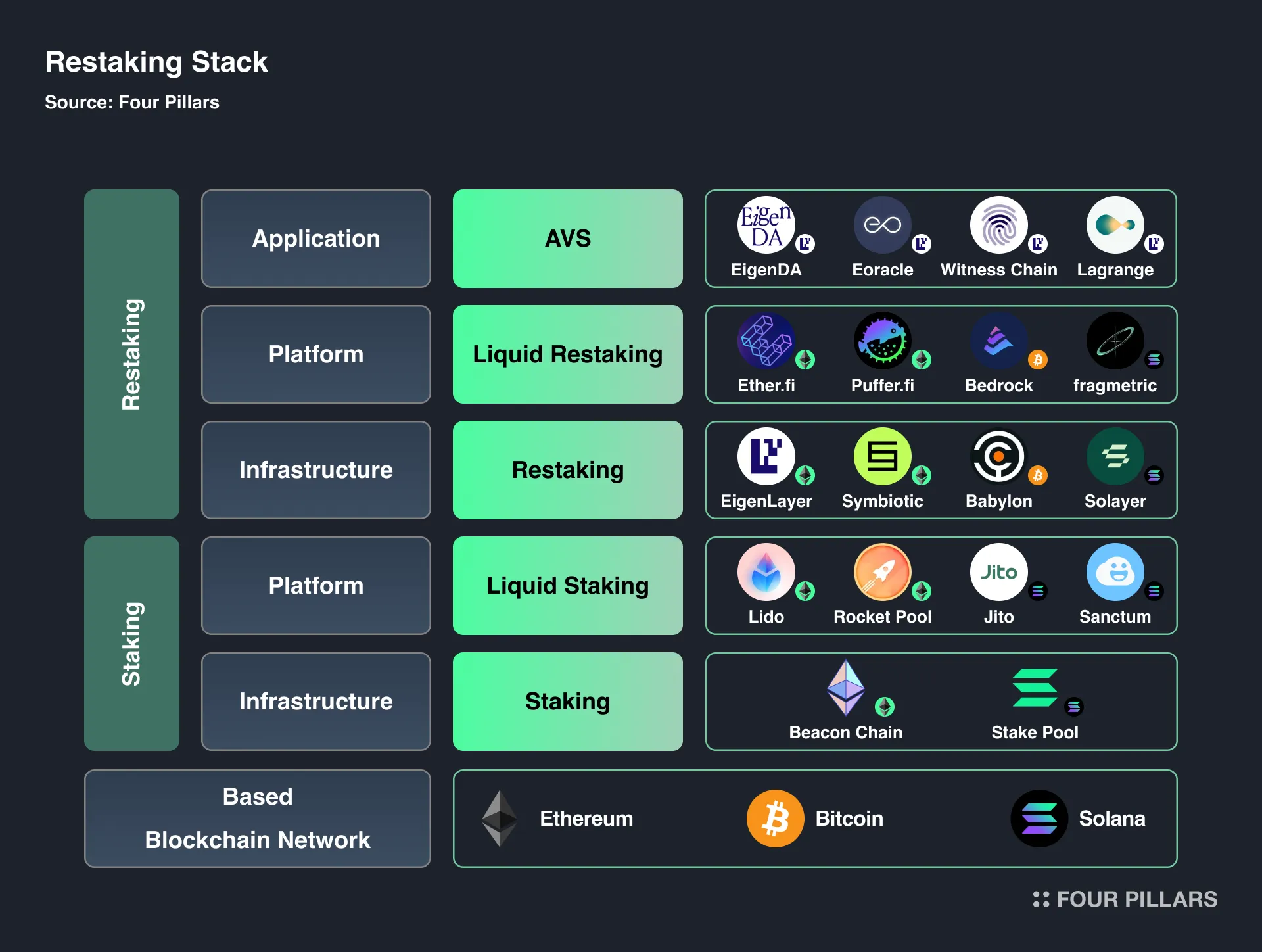
EigenLayer pioneered the concept of restaking, launching its services in June 2023. Since then, several innovative projects have emerged, inspired by the restaking model across different blockchain ecosystems. For example, Symbiotic and Karak have made significant strides within the Ethereum ecosystem, while Solayer and Jito have expanded into the Solana ecosystem. In the Bitcoin space, projects like Babylon have explored similar approaches. Additionally, Liquid Restaking Token (LRT) initiatives such as Ether.fi and Puffer.fi have built on the foundational concepts introduced by EigenLayer. This wave of development underscores the pivotal role EigenLayer has played in shaping the broader restaking ecosystem while fostering a collaborative and evolving space.
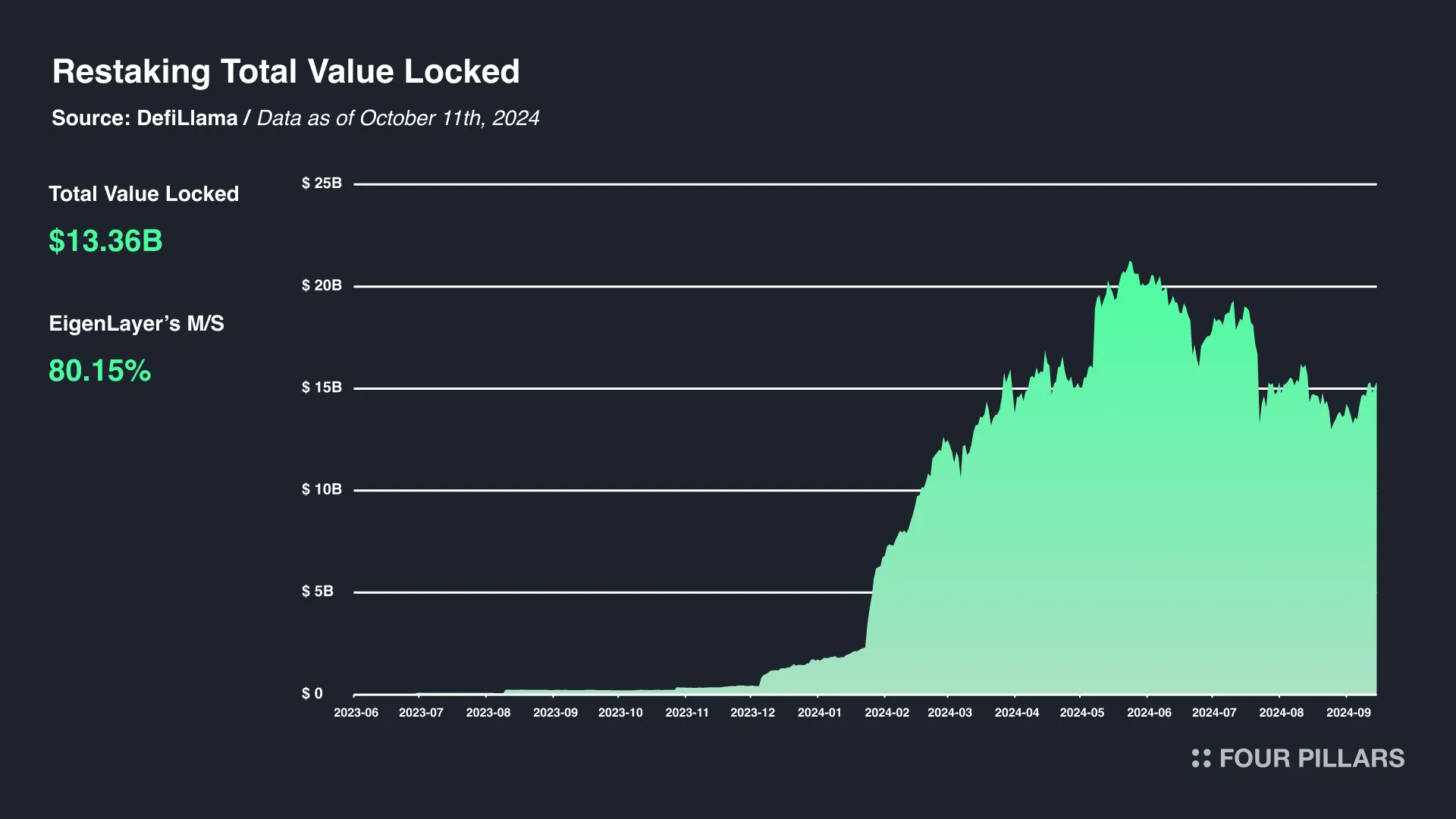
Market data further solidifies this dominance. As of October 11, 2024, the Total Value Locked (TVL) in restaking protocols reached approximately $13 billion, with EigenLayer alone holding around $10 billion (equivalent to 4.5 million $ETH), representing a commanding 80% market share. By contrast, Symbiotic and Karak hold market shares of 11.7% and 3.7%, respectively.
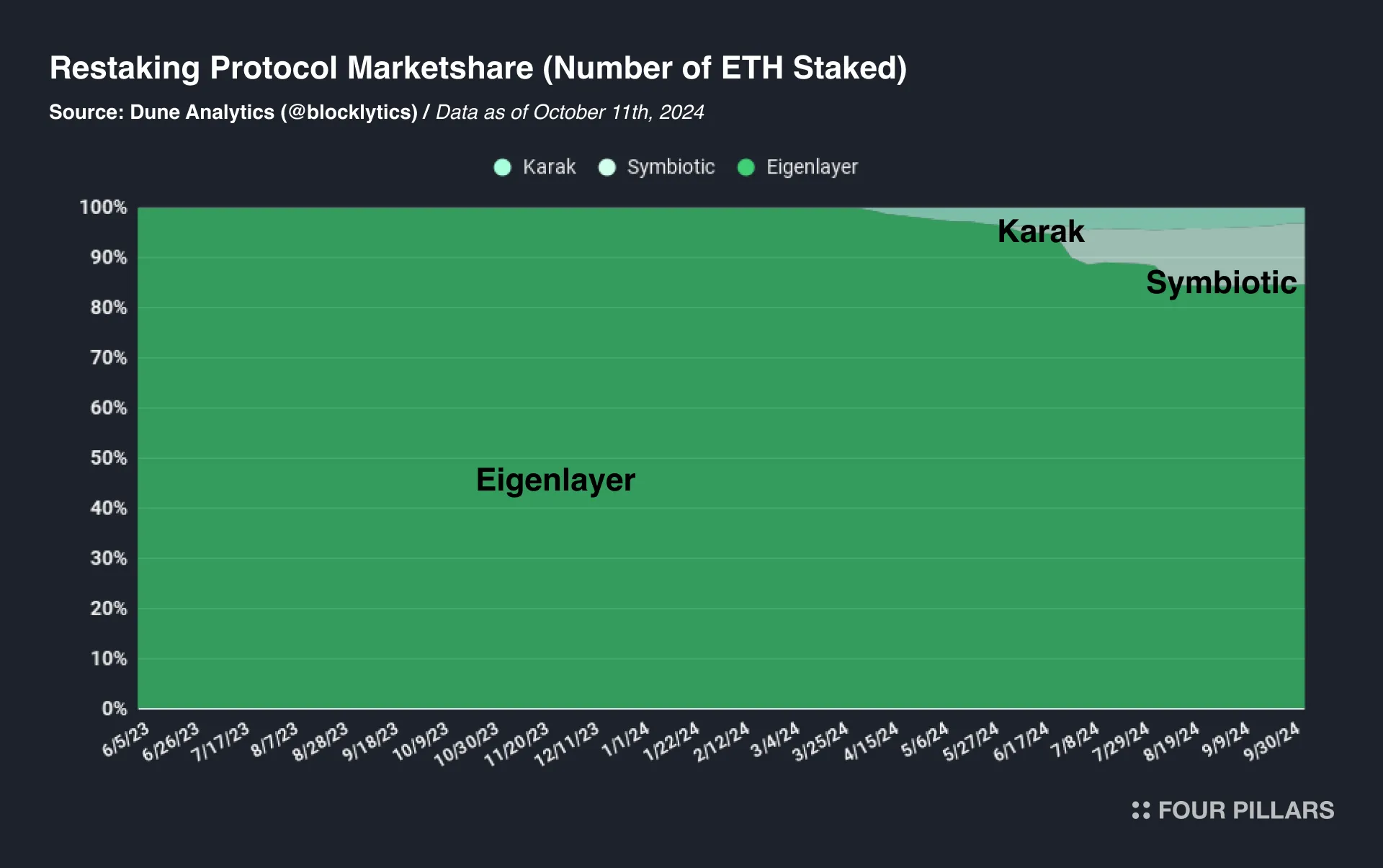
While EigenLayer maintains its leading market share, the most critical factor to monitor going forward is the pace of growth within the AVS ecosystem. Regardless of how advanced Eigenlayer’s technology is, its value remains limited without substantial user adoption and practical applications. Should ecosystem growth stagnate, Eigenlayer may lose market share to emerging competitors. More importantly, revenue generated by AVS is directly distributed to $EIGEN stakers as well, which means the success and expansion of AVS’ are closely tied to the value of $EIGEN.
Finally, while there isn't a clear market narrative driving demand for $EIGEN, a potential catalyst could emerge if the market starts to anticipate an "AVS airdrop" token, similar to the excitement that surrounded $TIA earlier this year. Should this narrative take hold, the growth of the AVS ecosystem could significantly boost demand for $EIGEN. As of now, there are 17 AVS projects under development on EigenLayer, including EigenDA, with many more likely in the pipeline. Additionally, 44 major networks—including Abstract, MegaETH, Mantle, and Movement—support or utilize EigenDA, highlighting its expanding footprint.

Related Articles, News, Tweets etc. :
Four Pillars - Restaking Stack: Categorizing the Restaking Ecosystem
The Chopping Block - EigenLayer vs. Celestia: Token wars or innovation clash?
hahahash - EigenLayer Ecosystem Metrics | The Ultimate Restaking Dashboard v1.6.0 | Dune Analytics
Eigenlayer Foundation - EIGEN: The Universal Intersubjective Work Token
Dive into 'Narratives' that will be important in the next year